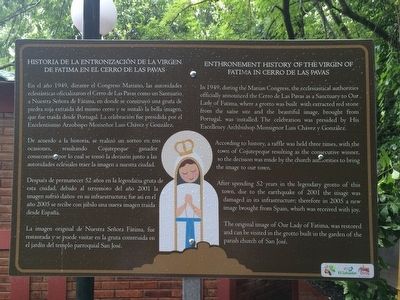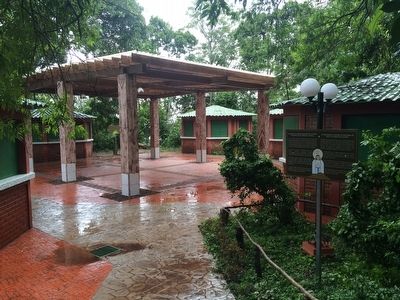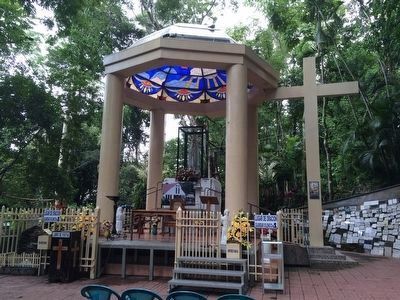Cojutepeque, Cuscatlán, El Salvador — Central America (West Coast)
History of the Virgin of Fatima in Cerro de las Pavas
Historia de la entronización de la Virgen de Fatima en el Cerro de las Pavas
Inscription.
De acuerdo a la historia, se realizó un sorteo en tres ocasiones, resultando Cojutepeque ganador consecutivo por lo cual se tomó la decisión junto a las autoridades eclesiales traer la imagen a nuestra ciudad.
Después de permanecer 52 años en la legendaria gruta de esta ciudad, debido al terremoto de 2001 al imagen sufrió daños en su infraestructura; fue así en el año 2005 se recibe con júbilo una nueva imagen traída desde España.
La imagen original de Nuestra Señora de Fátima, fue restaurada y se puede visitar en la gruta construida en el jardín del templo parroquial San José.
Enthronement History of the Virgin of Fatima in Cerro de las Pavas
In 1949, during the Marian Congress, the ecclesiastical authorities officially announced the Cerro de Las Pavas as a Sanctuary to Our Lady of Fatima, where a grotto was built with extracted red stone from the same site and the beautiful image, brought from Portugal, was installed. The celebration was presided by His Excellency Archbishop Monsignor Luis Chávez y González.
According to history, a raffle was held three times, with the town of Cojutepeque resulting as the consecutive winner, so the decision was made by the church authorities to bring the image to our town.
After spending 52 years in the legendary grotto of this town, due to the earthquake of 2001 the image was damaged in its infrastructure; therefore in 2005 a new image brought from Spain, which was received with joy.
Topics. This historical marker is listed in this topic list: Churches & Religion. A significant historical year for this entry is 1949.
Location. 13° 42.786′ N, 88° 56.182′ W. Marker is in Cojutepeque, Cuscatlán. The marker is near the food court entrance at the Cerro de las Pavas. Touch for map. Marker is in this post office area: Cojutepeque, Cuscatlán 01401, El Salvador. Touch for directions.
Other nearby markers. At least 8 other markers are within 19 kilometers of this marker, measured as the crow flies. History of Cerro de las Pavas (a few steps from this marker); Expansion of El Salvador's Telephone System (about 90 meters away, measured in a direct line); Father Alirio Napoleón Macías (approx. 16.2 kilometers
away); History of Ilobasco (approx. 16.7 kilometers away in Cabañas); Father Marino Braspenning (approx. 17.2 kilometers away in Cabañas); Apastepeque (approx. 17.6 kilometers away in San Vicente); Structure 1D1 or Southern Surveillance Point (approx. 19.1 kilometers away); Streets of Ciudad Vieja (approx. 19.3 kilometers away). Touch for a list and map of all markers in Cojutepeque.
Credits. This page was last revised on July 28, 2019. It was originally submitted on September 29, 2015, by J. Makali Bruton of Accra, Ghana. This page has been viewed 1,123 times since then and 69 times this year. Photos: 1, 2, 3. submitted on September 29, 2015, by J. Makali Bruton of Accra, Ghana.


